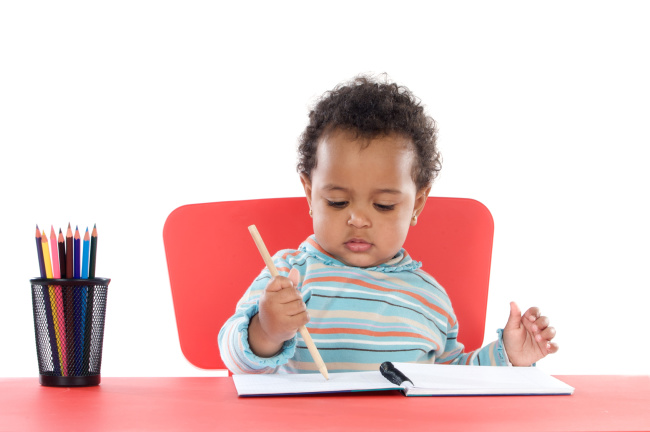For your child to be able to draw, colour or write, there are a number of skills he or she will have to learn and develop. These include;
- Forming a pincer grasp
- Left and right discrimination
- In-hand manipulation
- Finger isolation
- Hand-eye coordination
- Fine motor strength (using the small muscle groups in the fingers)
- Upper body strength (especially the larger muscles in the shoulder)
- Crossing the mid-line
- Bilateral coordination
- Visual perception
First year of development
During the first year, babies use their hands mainly to throw things or put them into their mouths, to unpack things or take them apart and to hit things. This all forms part of their development and is necessary to improve the above-mentioned skills.
Toddler scribbles
Most toddlers begin to scribble shortly after they are able to grasp a crayon, which usually happens when they are about a year old. They will hold the crayon with a palmar grasp (using their whole hand) with their thumb close to the opposite end of the tip. At this stage they will also start to manipulate objects with their hands.
Around two years of age, your toddler’s drawing skills will improve and they will start to experiment by drawing lines. After being shown how to do it, they should also be able to copy a circle and some vertical lines. As their hand function improves, they will hold the crayon lower, closer to the tip, and use their thumb, index and middle fingers to grip. They will also start using elbow instead of shoulder movements to scribble and draw.
Becoming a little artist
A year later, at three, their drawing skills will have improved to such an extent that your little artist will be able to copy a vertical and horizontal line, a circle and a cross (+). They will hold the crayon or pencil close to the tip with the thumb and the first two fingers, but now it will fit between thumb and index finger. They will have better control of it and will start to colour in simple pictures, although not staying within the lines.
Six months later you will be able to teach your child to trace his or her own name or to copy it after you’ve written it down for them.
Your four-year-old
At the age of four, your child will have a mature tripod grip and will use finger and wrist movements when drawing or colouring in. Their drawing skills will improve to such an extent that they will be able to draw a circle, square, rectangle and even a line between two other lines that are a few centimetres apart.
From about four-and-a-half, your child will use finger movements while drawing, colouring or writing. They will also start to support the paper with their other hand and be able to write one or two letters of their own name. They will also be able to colour in more accurately.
Colouring in the lines, writing their own name and drawing basic shapes
At five years old, they will be able to colour in between lines and have good control while writing and drawing. During this year, children usually learn to write their own name (depending on the length and difficulty of the name) and they will start to write numbers and letters. It is quite normal for them not to get these 100 per cent correct and they may still form letters the wrong way around.
By the age of six, you can teach your child to write their name and surname as well as all the basic shapes like circles, squares, rectangles, triangles and crosses.
Article by: Susanne Hugo, Mysmartkid’s occupational therapist. Visit www.mysmartkid.com or www.myslimkind.com, or call 0861 555 224 for more information.
Latest posts by Contributor (see all)
- Practical advice for keeping your toddler safe around the pool - December 18, 2014
- Is your pool toddler-proof? - December 18, 2014
- Is it worth it? - December 18, 2014
-
No Comments" href="https://all4baby.co.za/toddlers-1-2-years/learning-development-1-2-years/2730/real-life-toddler-easily-distracted/">

Real life: My toddler is easily distracted
-
No Comments" href="https://all4baby.co.za/toddlers-1-2-years/toddler-issues/2725/advice-mom-whos-toddler-not-speaking/">

Advice for a mom whose toddler is not speaking
-
No Comments" href="https://all4baby.co.za/toddlers-1-2-years/learning-development-1-2-years/2721/teach-toddler-new-concepts/">

How to teach your toddler new concepts
-
No Comments" href="https://all4baby.co.za/toddlers-1-2-years/learning-development-1-2-years/2708/toddler-understimulated/">

Is my toddler under-stimulated?


 Saving...
Saving...